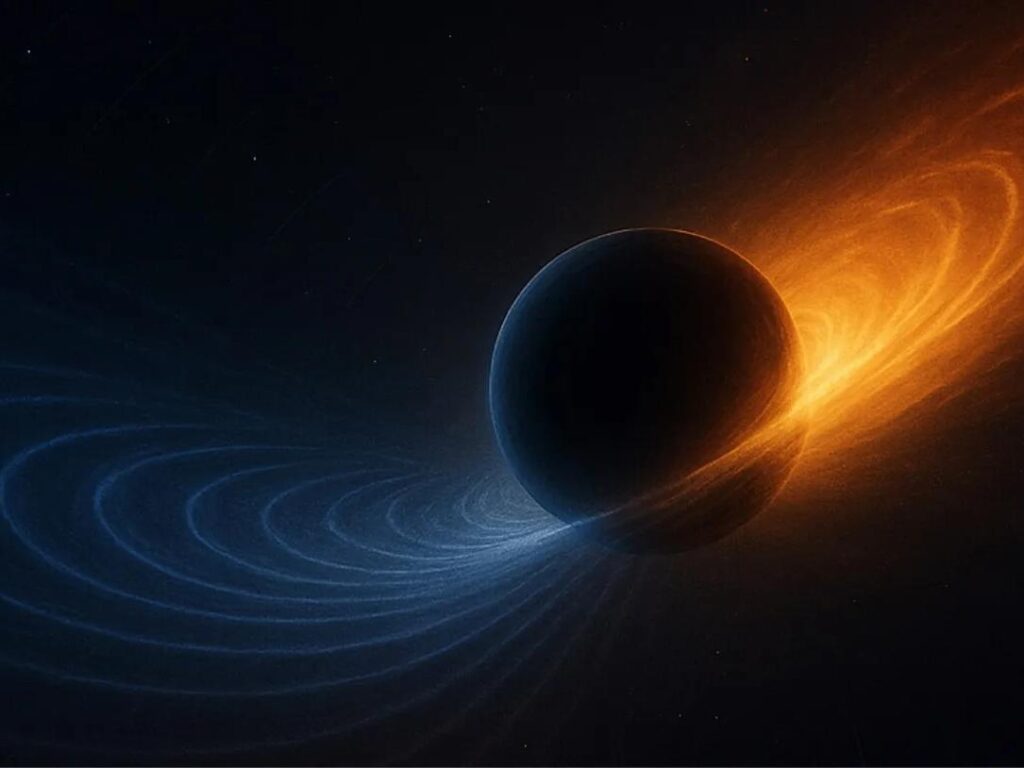
The violent collision and merger of two black holes, which emits gravitational waves—ripples in spacetime—has long intrigued scientists. These waves can cause the resulting newborn black hole to recoil and move rapidly, sometimes even escaping its own galaxy. Now, an international team, including a researcher from Penn State, has achieved a groundbreaking measurement: the direction and speed of this recoil for the first time.
The research, published in the journal Nature Astronomy, marks a significant advance in our understanding of black hole dynamics. “When two black holes spiral into each other and merge, they don’t just disappear quietly,” explained Koustav Chandra, a postdoctoral researcher in astronomy and astrophysics at the Penn State Eberly College of Science during the research, now at the Max Planck Institute for Gravitational Physics in Germany. “The violent collision emits gravitational waves that carry away energy and momentum. If the gravitational waves are emitted unevenly in different directions, it will create an imbalance that literally ‘kicks’ the newly formed black hole, sometimes at speeds of thousands of kilometers per second.”
The Science Behind the Discovery
Gravitational waves were first predicted by Einstein in 1916 but remained undetected until 2015. This was when the U.S. National Science Foundation’s Laser Interferometer Gravitational-Wave Observatory (NSF LIGO) first observed the merger of two black holes of similar sizes. Since then, nearly 300 such events have been detected. However, measuring the recoil of the remnant black hole required observations of a specific type of merger: two black holes with unequal masses.
The team analyzed GW190412, a merger of two black holes with unequal masses detected in 2019 by both LIGO and its gravitational wave-detecting counterpart in Italy, Virgo, during their third observing run. This mass imbalance was key because it created gravitational waves that appear significantly different depending on the observer’s position relative to the recoiling black hole.
“Gravitational waves from black-hole mergers can be understood as a superposition of different signals, much like an orchestra,” said Juan Calderón-Bustillo, professor at the Galician Institute for High Energy Physics at the University of Santiago de Compostela. “However, this orchestra is special: audiences located in various positions will hear slightly different combinations of instruments, helping them to understand their exact location around it.”
Implications for Astronomy
The researchers fully characterized the remnant black hole’s motion for the first time by combining these directional clues with predictions based on Einstein’s theory of general relativity for recoil speed based on the black holes’ masses and spins. They found that GW190412’s remnant was kicked at over 31 miles per second—fast enough to eject it from the globular cluster of stars where it was originally located. For the first time, the researchers also determined the kick’s direction relative to Earth and the original binary system.
“This is truly awesome!” Chandra exclaimed. “We’re not just detecting something—we’re actually reconstructing the motion of an object billions of light-years away using only ripples in spacetime. This is a step beyond most astronomical measurements, which often only give a two-dimensional projection.”
This work opens new possibilities in gravitational-wave astronomy, Chandra noted, by providing a technique to measure recoil measurements for future detections of asymmetric mergers with current technology. It may also improve the ability to pair up signals from “multi-messenger” events that emit both gravitational waves and electromagnetic radiation observed with different detectors on Earth and in space.
Future Prospects and Broader Impact
“Black-hole mergers in dense environments can lead to detectable electromagnetic signals—known as flares—as the remnant black hole traverses a dense environment like an active galactic nucleus,” said Samson Hin Wai Leong, a doctoral student at the Chinese University of Hong Kong. “Because the visibility of the flare depends on the recoil’s orientation relative to Earth, measuring the recoils will allow us to distinguish between a true gravitational wave-electromagnetic signal pair that comes from a binary black hole and just a random coincidence.”
Beyond recoils, the team stated that their methods provide a new toolkit for exploring other subtle properties of these violent astronomical events, expanding the ability to study the universe’s most extreme phenomena.
The Penn State contributions to this work were funded by the U.S. National Science Foundation. As the field of gravitational-wave astronomy continues to evolve, these findings pave the way for more sophisticated analyses and a deeper understanding of the cosmos.





